A variety with an exotic taste and amazing appearance - the “Irish Liqueur” tomato: we grow and surprise our neighbors
The green color of tomatoes does not always indicate their immaturity. Breeders have bred varieties, the fruits of which retain their green tint even when mature. Such tomatoes not only have an unusual appearance, but also have an unusual taste. The fruit contains chlorophyll. It helps to normalize metabolism, increase immunity, better oxygenate the body and increase overall tone.
Most green tomatoes are not very productive. They are demanding to care for and often get sick. Irish liqueur tomato is devoid of these disadvantages. What are the advantages of this variety and how to grow it on your site - read on.
The content of the article
General description of the variety
Irish liqueur is a varietal tomato. It appeared relatively recently in the markets of our country, but has already managed to win the love of gardeners. This tomato has not yet been entered into the state register.
Advice... Since Irish Liqueur is a cultivar and not a hybrid, the seeds from its fruit can be used for further planting.

The distinctive couple of Irish liquor
The main distinguishing feature of the Irish liqueur is the unusual color of its fruits. When ripe, the berries of this tomato variety acquire a green-yellow tint. Therefore, it is difficult for gardeners who grow it for the first time to determine the stage of maturity of tomatoes.
Tomatoes of this variety are classified as large-fruited. On average, the weight of the fruits varies within 200-300 g. There are also larger specimens.
The green color is due to the high content of chlorophyll in their composition. This substance has a positive effect on the state of the body, normalizing all processes in it. In addition, these tomatoes are less likely to cause allergies than their red-fruited counterparts.
The taste of green tomatoes is also unusual. The Irish liqueur fruit is soft and juicy. They are sweet, with a subtle sourness and a pronounced fruity flavor.
Interesting... Tomato Irish liquor is often compared to another green-fruited tomato - the Malachite Box. Gardeners agree that the second option has a sweeter taste without sourness, but its fruits are less flavorful.
Tomato bushes are tall. They need timely shaping and garters. Tomatoes of this variety rarely get sick. They are almost never affected by late blight.
Specifications
Irish liqueur characteristics are not very different from other green-fruited varieties. Let's consider them in more detail in the table.
| Parameter | Indicators |
| Bush type | Tall indeterminate tomato. Its bush reaches a height of 1.5 m. The stem is thick and powerful, slightly leafy. Little stepsons are formed. The leaf blade is ordinary, has an average size, there is a slight pubescence. The color of the leaves is light green. The inflorescences are simple. The first is formed in the axil of the ninth leaf. The next ones are born every 2-3 leaves. The fruits are formed by tassels. One brush contains from three to five berries. |
| Growing method | A thermophilic variety that does not tolerate temperature fluctuations. In the northern and central regions, it is grown in greenhouses and film shelters.In the south, open field cultivation is possible. |
| Yield | Average. Up to 4 kg of tomatoes are obtained from one bush. According to gardeners, from 1 sq. m it is possible to collect up to 14 kg of tomatoes. |
| Fruit | Large. On average, the weight of one fruit varies between 200-300 g. The maximum weight of this variety is 600 g. Outside, the fruits are light green with a yellowish tinge. Covered with dark green stripes. Inside, the berries are light green, with a light spot in the center and dark green areas around the seed chambers. The shape of the berries is round-flattened. There is a pronounced ribbing at the base. The fruits are juicy and soft, there is a lot of pulp. The taste is sweet with a subtle sourness and an unusual aftertaste. There are 6-7 chambers in each berry. Each of them contains a small amount of small seeds. |
| Transportability | Low. Ripe fruits are soft. Easily damaged when pressed. Stored for no more than two weeks. |
| Ripening terms | Medium late. The fruits ripen 115-120 days after sowing the seeds. Fruiting continues until the first frost. |
| Disease resistance | There is immunity to tomato diseases. |
note! Irish liqueur is a new variety that is not listed on the government register. Therefore, conclusions about its resistance to late blight and other tomato diseases are made on the basis of numerous reviews of gardeners who have already grown it.
Growing seedlings
Seedlings of exotic varieties are rarely found in the markets. You will have to grow it yourself. Even a novice gardener can cope with this task, provided that the basic rules are followed.
Sowing seeds begins in March. From the moment the first shoots appear until the tomatoes are planted in a permanent place, no more than 55 days should pass.
Seed preparation
Before use, the seeds must be treated with a number of preparations. This will help reduce the likelihood of plant infection, increase their resistance to negative factors from the outside and accelerate the germination of planting material.
Before you start working with planting material, you need to check it for germination. To do this, the seeds are soaked for 30 minutes in salted water. Only those that have sunk to the bottom are considered suitable for planting. They are washed and dried.
To reduce the likelihood of tomato infestation, seeds are treated with disinfectants. They are usually soaked at home in the following formulations:
- in a light pink solution potassium permanganate for 30 minutes;
- in hydrogen peroxide for 15 minutes;
- in a solution of soda for 12 hours;
- in aloe juice for 12 hours;
- in "Fitosporin" for 6 hours.
Then the seeds are treated with growth stimulants. For this, the planting material is soaked in "Epin", "Sodium humate", "Zircon" or in honey water.
Some gardeners prefer to plant seeds that have already sprouted. To germinate the planting material, it is wrapped in pieces of gauze dipped in warm water or a growth stimulator. The material with the seeds is placed in deep saucers, which are covered with foil and placed in a warm place. It usually takes 3 days to germinate seeds in this way.
Selection of containers and soil
Tomato seeds are often sown in one large container. To do this, use wooden boxes or plastic trays. Containers for sowing planting material are made from available tools. Disposable deep plates, packaging for meat products, semi-finished products and desserts are suitable.
Tomatoes dive into separate containers. It is most convenient to use peat pots, from which you do not need to extract the plants when transplanting to a permanent place. Plastic pots, cut bottles, and disposable cups are also suitable.
Advice... Usually gardeners plant several bushes of green-fruited tomatoes in their area. In this case, it is advisable to use peat tablets for growing seedlings.
All containers should be decontaminated before use.To do this, they are doused with boiling water or soaked for half an hour in a dark pink solution of potassium permanganate.
Soil for tomato seedlings is bought in a store or prepared independently. In any case, the soil is disinfected by sprinkling with a strong solution of potassium permanganate, copper sulfate or boiling water.
To make up the soil mixture yourself, you need to mix peat, black soil and humus in equal proportions. Sand and ash are added to the resulting composition.
Sowing planting material
The soil is poured into the seedling boxes. It is poured abundantly with warm, settled water. Grooves are made in the soil at a distance of 3 cm from each other, into which the seeds are then placed with an interval of 2 cm.
The seed grooves are covered with earth. The containers are covered with foil and placed in a warm place. It doesn't have to be well lit.
If the seeds are sown in peat tablets, then the technology will be slightly different. In this case, the workpieces with peat are soaked in boiling water until they are completely swollen. Then one seed is planted in the resulting bags. Tablets with seeds are placed in one large container, which is covered with a film and removed to a warm place.
Seedling care
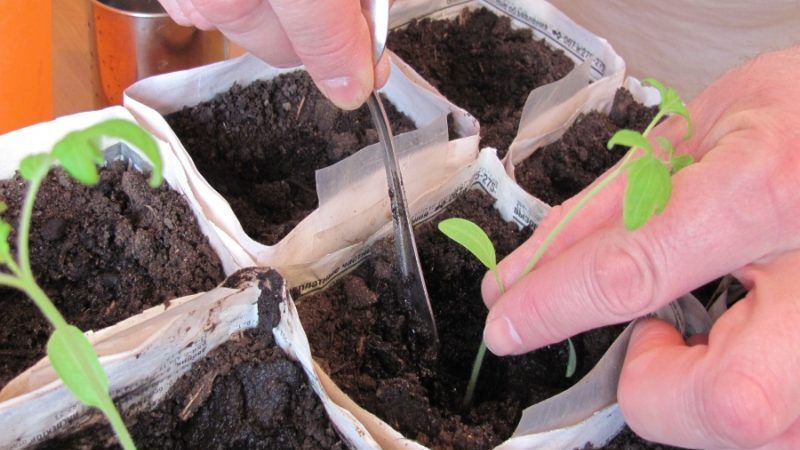
Many novice gardeners are afraid to grow seedlings on their own, thinking that caring for them will take a lot of time. However, following simple rules, it will not be difficult to get healthy and viable plants:
- Until the seeds germinate, the tomatoes are kept under a film. This allows you to create conditions of high humidity, which are necessary for tomatoes at this stage. The soil is moistened as it dries from a spray bottle.
- After the first shoots appear, the boxes with the seedlings are rearranged in a well-lit, but cool place. The temperature in it should vary between 15-17 degrees.
- A week later, the boxes with seedlings are put back in the heat. At this stage, tomatoes need sixteen hours of daylight. In spring, natural light is usually insufficient. Gardeners recommend using fluorescent lamps.
- When sprouted tomatoes are in a common box, they are watered with a pipette or syringe. This is done so that the liquid does not get on the ground part of the plants.
- After the first true leaves appear in the seedlings, they are seated in individual containers. A drainage layer is poured onto the bottom of the pots.
- Seedlings planted in separate pots are watered from a watering can. Also, water should not fall on the ground part.
- Tomatoes are fed 3 times during the growing period. They use special fertilizers for seedlings, vermicompost or complex mineral fertilizers. The first time feeding is applied two weeks after the picking of the plants, the last one - 3 days before planting in a permanent place.
- 14 days before picking tomatoes in the ground, they begin to harden. For this, the seedlings are taken out into the street. The first day for 30 minutes, the second for 1 hour, the third for 2 hours, etc.
Agrotechnics
In the south of our country, tomatoes are planted in open ground in early May. At the same time, it is possible to plant seedlings in unheated greenhouses in the central regions. In northern Russia, tomatoes are planted in greenhouses at the end of May.
Before planting seedlings in a permanent place, they are watered and fed. This must be done 3 days before the procedure.
Planting seedlings in a permanent place
It is important to choose a suitable place for tomatoes. It should be well lit. Tomato beds should not have nightshade crops in the last three years.
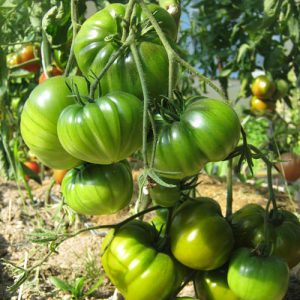 In the fall, the selected area is dug up and cleaned of weeds. Humus and dry lime are added to the soil. This makes it more fertile and lowers its acidity.
In the fall, the selected area is dug up and cleaned of weeds. Humus and dry lime are added to the soil. This makes it more fertile and lowers its acidity.
In the spring, the beds are dug up again. All roots that have managed to form are removed. The soil is watered with a solution of chicken manure and disinfected with copper sulfate.
The holes are dug in a checkerboard pattern. The distance between the rows should be 60 cm, and between the plants - 50-60 cm. For 1 sq. m place no more than three plants.
A handful of ash or granular long-acting fertilizers are poured into each well. The plant is placed there, forming its root system towards the center. The stem is buried, breaking off several lower sheets.
Each planted tomato is watered with warm water. At least 1 liter of liquid is consumed per plant. The next watering is possible in two weeks.
Tomato care
Tomato Irish liquor must be tied up. Otherwise, its stems will simply break under the weight of the fruit. For the garter, a wooden support is used, to which the plant is attached with a synthetic thread.
Form the tomatoes into 1 or 3 stems. The more stems remain, the more abundant the harvest will be, but less fruit.
In the process of pinching, not only unnecessary processes are removed, but also the lower and yellowed leaves. It is important to do this carefully so that you get a not very big "wound".
Water the plants abundantly, but infrequently. For 1 tomato, 2-2.5 liters of water are used. This procedure is performed early in the morning or at sunset.
It is important to loosen the soil after watering. This will prevent the formation of an earth crust and restore root air exchange. The procedure should be carried out after precipitation falls.
Fertilizers are applied 3-4 times per season. Organic and mineral compositions alternate. Fresh manure cannot be used for tomatoes, it will burn the plant roots.
Foliar dressing is used 2 times per season. Boron formulations are recommended.
Useful Tips
To get the maximum tomato yield Irish liquor, we advise you to consider a few tricks: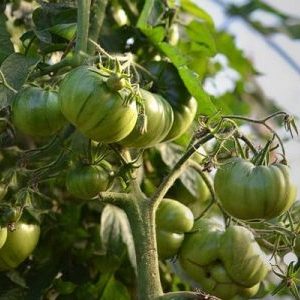
- If several waterings have been missed, then you cannot pour a large amount of liquid onto the plant at once. This is especially true of the fruiting period. The lack of moisture must be replenished in small portions in several steps. To optimize soil moisture, a drip irrigation system is used.
- Experienced gardeners will often place a cut bottle ring around the plant roots in the hole. This design protects tomatoes from the bear and provides a quick flow of moisture to the roots.
- To pollinate the tomatoes faster, the bushes are shaken daily.
- Leaves are removed above the fruits. This increases the rate at which the berries ripen.
- Tomatoes are nursed once a week. In one procedure, no more than three shoots are removed.
Diseases and pests
According to gardeners, Irish liquor tomatoes rarely infect diseases. They don't get sick late blight and other tomato diseases.
Disease prevention is the key to successful tomato cultivation. To prevent infection of plants, you need: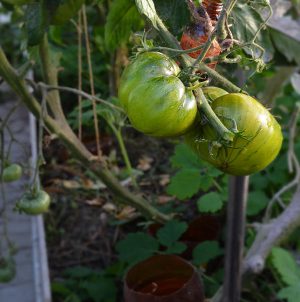
- Disinfect soil, soil and containers that come into contact with plants. The seeds should also be disinfected.
- Before planting tomatoes in the beds, you need to remove all plant residues.
- Follow the rules glaze and pinching.
- Weekly process the bushes with a solution of potassium permanganate, Bordeaux liquid, copper sulfate.
- Spray the bushes with soapy water and wormwood decoction to protect against pests. Large insects must be removed by hand.
Features of cultivation in open and protected ground
When growing tomatoes in the open field, it is important to cover the plants with foil for the first two weeks after the pick. In the afternoon, the shelter is removed. On cold days, such protection is used in the daytime.
Before planting tomatoes in a greenhouse, its walls are treated with copper sulfate. The room is ventilated daily by opening the vents in it. Tomatoes are not afraid of drafts.
Harvesting and application of the crop
In early August, the first ripe fruits are harvested. They are collected by the piece, since this variety does not differ in maturity.
The ripeness of tomatoes can be judged by the yellow-green color of the berries. They will feel soft to the touch.
Irish liqueur is a salad variety. Its fruits are also used for making juices and sauces of unusual colors. Red and yellow tomatoes, covered in green tomato sauce, look very original.
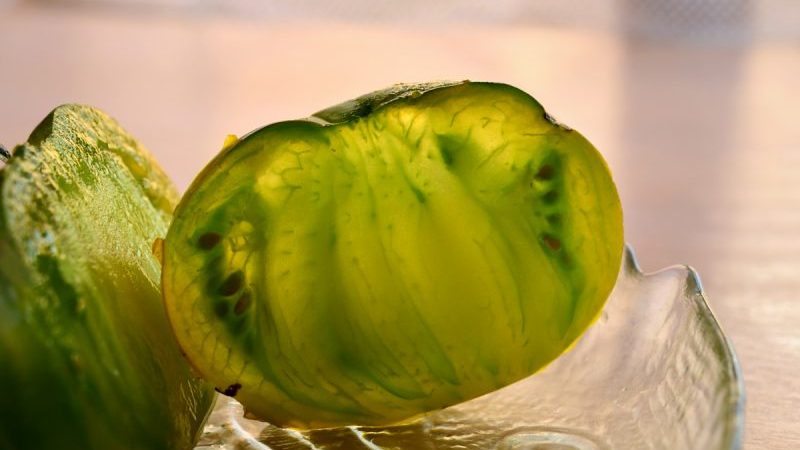
Advantages and disadvantages of the variety
Benefits of Irish Liqueur:
- unusual appearance;
- pleasant sweet taste;
- increased content of nutrients in the composition;
- rarely causes allergies;
- immunity to tomato diseases.
Disadvantages of the variety:
- the need for pinching and garter;
- low transportability;
- instability to temperature fluctuations.
Farmers reviews
Reviews of farmers about the tomato Irish liqueur are positive. Many gardeners believe that it is even better than the Malachite Box.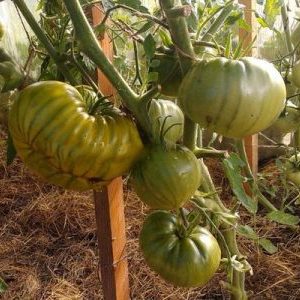
Irina, Zelenograd: «Tomato Irish liquor is first planted this year. I liked the result. I planted only 4 bushes, from which I collected 2 buckets of fruit. The largest tomato weighed 400 g. Seeds from the first fruits were collected for the next planting. Separated the pulp from the seeds using a sieve. Washed, dried and placed in fabric bags. "
Gennady, Krasnodar: “I have been planting Irish liqueur for the second year. In my experience it grows better in greenhouses. I did not suffer from late blight or rot. I liked the taste. The color is really green, as in the photo. "
Conclusion
Tomato Irish liquor will surprise experimental gardeners. Its fruits are green when ripe. Contrary to all expectations, they are not hard and sour, but soft, sweet, with a fruity flavor. They are used for dietary nutrition due to their low allergenicity and high content of nutrients.
It is not difficult to grow such exotic tomatoes. They require careful and regular care, but are not afraid of tomato diseases.